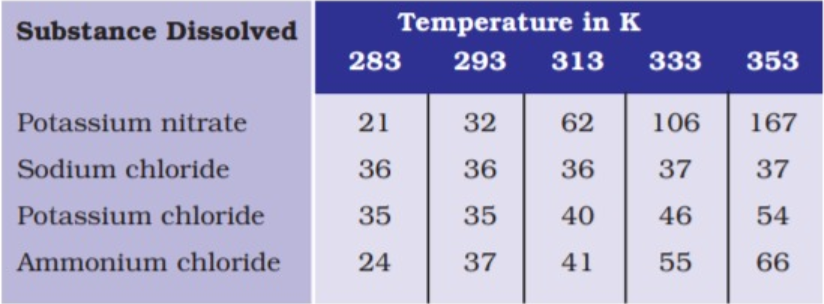Complete Solutions to Exercise of chapter IS MATTER AROUND US PURE? of Class 9 book with complete answers and questions
| Class 9 | CHEMISTRY |
| Chapter | IS MATTER AROUND US PURE? |
| NCERT | Exercise |
| Number Of Questions | 17 |
| Academic Year | 2023-24 |
What is meant by a substance ?
00:56View SolutionList the points of differences between homogeneous and heterogenous mixtures.
03:09View SolutionDifferentiate between homogeneous and heterogeneous mixtures with examples.
02:51View SolutionHow are sol, solution and suspension different from each other ?
03:07View SolutionTo make a saturated solution, 36 g of sodium chloride is dissolved in 100 g of water at 293 K. Find its concentration at this temperature.
01:26View SolutionClassify the following as chemical or physical changes :
`**` cutting of trees.
`**` melting of butter in a pan,
`**` rusting of almirah,
`**` boiling of water to form steam,
`**` passing of electric current, through water and the water breaking down into hydrogen and oxygen gases.
`**` dissolving common salt in water,
`**` making a fruit salad with raw fruits, and
`**` burning of paper and wood.04:11View SolutionWhich separation techniques will you apply for the separation of the following ?
(a) Sodium chloride from its solution in water.
(b) Ammonium chloride from a mixture containing sodium chloride and ammonium chloride.
(c ) Small pieces of metal in the engine oil of a car.
(d) Different pigments from an extract of flower petals.
(e ) Butter from curd.
(f) Oil from tea.
(g) Tea leaves from tea.
(h) Iron pins from sand.
(i) Wheat grains from husk.
(j) Fine mud particles suspended in water.04:30View SolutionWrite the steps you would use for making tea. Use the words solution, solvent, solute, dissolve, soluble, insoluble, filtrate and residue.
03:45View SolutionPragya tested the solubility of three different substances at different temperatures and collected the data as given below (results are given in the following table, as grams of substance dissolved in 100 grams of water to form a saturated solution).

(a) What mass of potassium nitrate would be needed to produce a saturated solution of potassium nitrate in 50 grams of water at 313 K ?
(b) Pragya makes a saturated solution of potassium chloride in water at 353 K and leaves the solution to cool at room temperature. What would she observe as the solution cools ? Explain.
(c ) Find the solubility of each salt at 293 K . Which salt has the highest solubility at this temperature ?
(d) What is the effect of change of temperature on the solubility of a salt ?View SolutionExplain the following giving examples.
(a) Saturated solution
(b) pure substance
(c ) colloid
(d) suspension05:31View SolutionClassify each of the following as a homogeneous or heterogeneous mixture.
soda water, wood , air, soil , vinegar, filtered tea.06:16View SolutionHow would you confirm that a colourless liquid given to you is pure water ?
01:41View SolutionWhich of the following materials fall in the category of a pure substance ?
(a) Ice
(b) Milk
(c ) Iron
(d) Hydrochloric acid
(e ) Calcium oxide
(f) Mercury
(g) Brick
(h) Wood
(i) Air.05:58View SolutionIdentify the solutions among the following mixtures.
(a) Soil
(b) Sea water
(c ) Air
(d) Coal
(e ) Soda water.02:21View SolutionWhich of the following will show "Tyndall effect "?
(a) Salt solution
(b) Milk
(c ) Copper sulphate solution
(d) Starch solution.01:47View SolutionClassify the following into elements, compounds and mixtures.
(a) Sodium
(b) Soil
(c ) Sugar solution
(d) Silver
(e ) Calcium carbonate
(f) Tin
(g) Silicon
(h) Coal
(i) Air
(j) Soap
(k) Methane
(l) Carbon dioxide
(m) Blood05:38View SolutionWhich of the following are chemical changes ?
(a) Growth of a plant
(b) Rusting of iron
(c ) Mixing of iron filings and sand
(d) Cooking of food
(e ) Digestion of food
(f) Freezing of water
(g) Burning of a candle04:46View Solution
Exercise questions and complete solutions for chapter IS MATTER AROUND US PURE? of NCERT CHEMISTRY(ENGLISH) of Class 9
